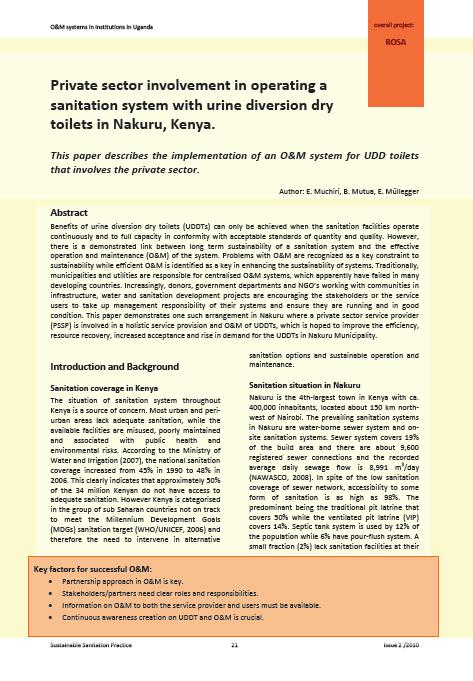Private sector involvement in operating a sanitation system with urine diversion dry toilets in Nakuru, Kenya
Muchiri, E., Mutua, B., Muellegger, E. (2010)

Published in: 2010
Publisher:
Sustainable Sanitation Practice Issue 2, Ecosan Club, Austria
Author:
Muchiri, E., Mutua, B., Muellegger, E.
Uploaded by:
SuSanA secretariat
Partner profile:
common upload
5053 Views
26 Downloads
Location of library entry
Content - Summary
This paper describes the implementation of an O&M system for UDD toilets that involves the private sector.
Benefits of urine diversion dry toilets (UDDTs) can only be achieved when the sanitation facilities operate continuously and to full capacity in conformity with acceptable standards of quantity and quality. However, there is a demonstrated link between long term sustainability of a sanitation system and the effective operation and maintenance (O&M) of the system. Problems with O&M are recognized as a key constraint to sustainability while efficient O&M is identified as a key in enhancing the sustainability of systems. Traditionally, municipalities and utilities are responsible for centralised O&M systems, which apparently have failed in many developing countries. Increasingly, donors, government departments and NGO’s working with communities in infrastructure, water and sanitation development projects are encouraging the stakeholders or the service users to take up management responsibility of their systems and ensure they are running and in good condition. This paper demonstrates one such arrangement in Nakuru where a private sector service provider (PSSP) is involved in a holistic service provision and O&M of UDDTs, which is hoped to improve the efficiency, resource recovery, increased acceptance and rise in demand for the UDDTs in Nakuru Municipality.
Bibliographic information
Muchiri, E., Mutua, B., Muellegger, E. (2010). Private sector involvement in operating a sanitation system with urine diversion dry toilets in Nakuru, Kenya. Sustainable Sanitation Practice Issue 2, Ecosan Club, Austria
Filter tags
English Sub-Saharan Africa Urine diversion dehydration toilets (UDDTs)















